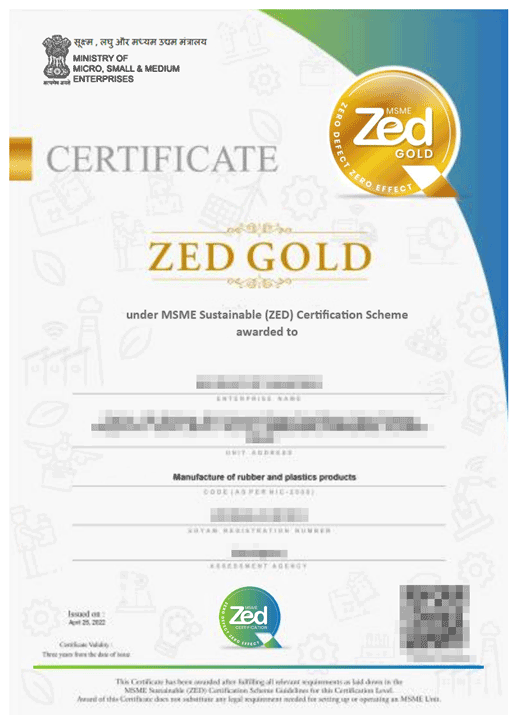Updated on December 20, 2025 01:16:07 PM
The Ministry of MSME launched the Zero Defect Zero Effect (ZED) Certification Scheme of the Government of India, with the ZED Gold Certificate being the third level of recognition. Micro, Small, and Medium-Sized Enterprises (MSMEs) that have advanced past the Silver stage and shown a greater level of excellence in environmental sustainability, innovation, workplace safety, and quality management are given this award.
An organization can demonstrate that it continuously adheres to structured procedures for zero-defect production while guaranteeing zero environmental impact by earning the ZED Gold Certification. In addition to enhancing company credibility, this certification gives businesses more chances to receive government incentives, gain international recognition, and enter lucrative markets.
The MSME's dedication to advanced compliance, sustainable growth, and ongoing improvement is demonstrated by the Gold level, which acts as a standard for operational excellence. For companies hoping to obtain even more advanced certifications, such as ZED Diamond and Platinum, it serves as a bridge.
ZED Gold Certificate

The Ministry of MSME oversees the ZED Certification Scheme of the Government of India, which offers the ZED Gold Certification as an advanced level of recognition. It is given to Micro, Small, and Medium-Sized Businesses (MSMEs) that have effectively outperformed the Silver and Silver levels and continuously put in place robust systems for environmental responsibility, innovation, workplace safety, and quality assurance.
By meeting both national and international standards, this certification shows that a company is dedicated to creating products with zero defects and no environmental impact. The ability of an MSME to implement contemporary procedures, cut waste, maximize resources, and uphold superior customer satisfaction is also reflected in the ZED Gold Certificate.

Here are given some Importance of ZED Gold Certificate:-

To apply for the ZED Gold Certificate, an MSME must provide the following documents:

The ZED Gold Certification process is designed to evaluate MSMEs on advanced parameters of quality, sustainability, and innovation. Follow the steps below:

Generally speaking, the ZED Certificate granted by the Ministry of MSME under the Zero Defect Zero Effect (ZED) Certification Scheme is good for three years after it is issued. All certification levels: Bronze, Silver, Gold, Diamond, and Platinum are covered by this.
Businesses must apply for renewal after the validity period expires, or they can decide to upgrade to a higher-level ZED certification by proving better adherence to advanced parameters. Maintaining quality standards, workplace safety, and environmentally friendly practices through regular renewal guarantees that MSMEs will continue to qualify for government incentives and benefits under the ZED scheme.

The ZED Gold Certification cost in India is ₹1,40,000, which includes a ₹90,000 government certification cost and a ₹50,000 professional assistance cost, mandatory for all MSMEs applying under the ZED scheme.
| Certification level | Gold |
|---|---|
| Government fees | 90,000 |
| Professional fees | 50,000 |
Note: The aforementioned Fees is exclusive of GST.

The ZED Gold Certification evaluates MSMEs on advanced benchmarks that reflect excellence in quality, sustainability, and competitiveness. The main parameters include:

Conclusion
The ZED Gold Certificate is a valuable asset for MSMEs. It demonstrates the MSME's commitment to quality, safety, and environmental protection. The certificate can also help the MSME to attract new customers and partners, and to gain access to government subsidies and incentives. The process of obtaining the ZED Gold Certificate can be time-consuming and challenging, but the benefits of achieving this certification are significant. If you are an MSME that is committed to quality and excellence, then the ZED Gold Certificate is a valuable goal to strive for.

Professional Utilities simplify registrations, licenses, and compliances for your business. With experienced guidance and nationwide support, we help you complete every requirement efficiently and effectively.






"Explore how Professional Utilities have helped businesses reach new heights as their trusted partner."

It was a great experience working with Professional Utilities. They have provided the smoothly. It shows the amount of confidence they are having in their field of work.

Atish Singh
It was professional and friendly experience quick response and remarkable assistance. I loved PU service for section 8 company registration for our Vidyadhare Foundation.

Ravi Kumar
I needed a material safety data sheet for my product and they got it delivered in just 3 days. I am very happy with their professional and timely service. Trust me you can count on them.

Ananya Sharma
Great & helpful support by everyone. I got response & support whenever I called to your system. Heartly thanx for Great & Super Service. Have a Great & Bright future of team & your company.

Prashant Agawekar
Thank you so much Professional Utilities team for their wonderful help. I really appreciate your efforts in getting start business. Pvt Ltd company registration was smooth yet quick.

Abhishek Kumar
I applied for Drug licence and company registration and their follow-up for work and regular updates helped me a lot. They are happily available for any kind of business consultancy.

Vidushi Saini
Great experience went to get my ITR done, process was quite convenient and fast. Had a few queries, am happy about the fact those people explained me all things I wanted to know.

Taniya Garyali
Great services provided by Professional Utilities. They are best in this industry and the best part is their prices are so affordable. Kudos to you. Now you guys are my full-time consultant.

Aftab Alam
Online Company Registration in India gives businesses a legal identity, allowing them to operate officially, open bank accounts, and access government benefits. In the middle of this process, company registration in India ensures smooth compliance and faster approval through digital filing.
The company which has the rating Above 3.0 to 3.5 is eligible for ZED gold certificate. Hence this is the third level of certification
The requirements for achieving a ZED Gold Certificate are rigorous and include:
The Government of India provides financial incentives to MSMEs that achieve a ZED Gold Certificate. These incentives include:
Speak Directly to our Expert Today

Reliable

Affordable

Assured